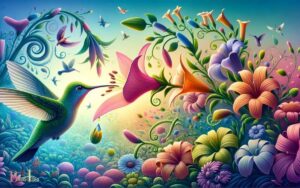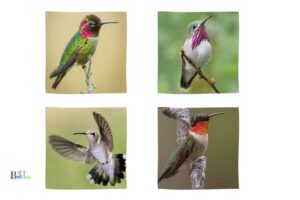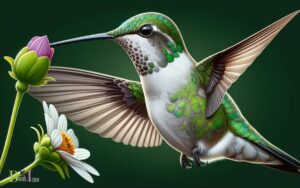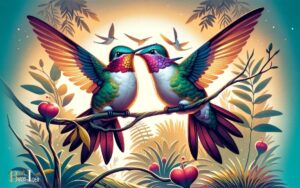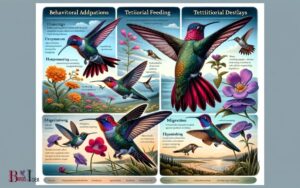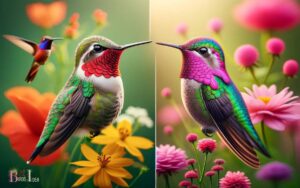What Type of Flowers Do Hummingbirds Like? Brightly Colored!
Hummingbirds are attracted to a wide variety of flowers, but they have a preference for those that are brightly colored, tubular-shaped, and rich in nectar.
Some of the best flowers for attracting hummingbirds include bee balm, cardinal flower, zinnia, salvia, and trumpet vine.
These flowers not only provide the necessary nectar but also have the right structure for hummingbirds to feed efficiently.
Hummingbirds are specialized nectar feeders, and their feeding preferences influence the types of flowers they are drawn to.
Here’s why they like certain flowers:
For example, a garden with a mix of red salvia, purple bee balm, and pink zinnias would not only be visually appealing but also a hummingbird magnet.
Creating a hummingbird-friendly garden with a collection of vibrant, nectar-rich flowers can transform your outdoor space into a lively hummingbird haven.
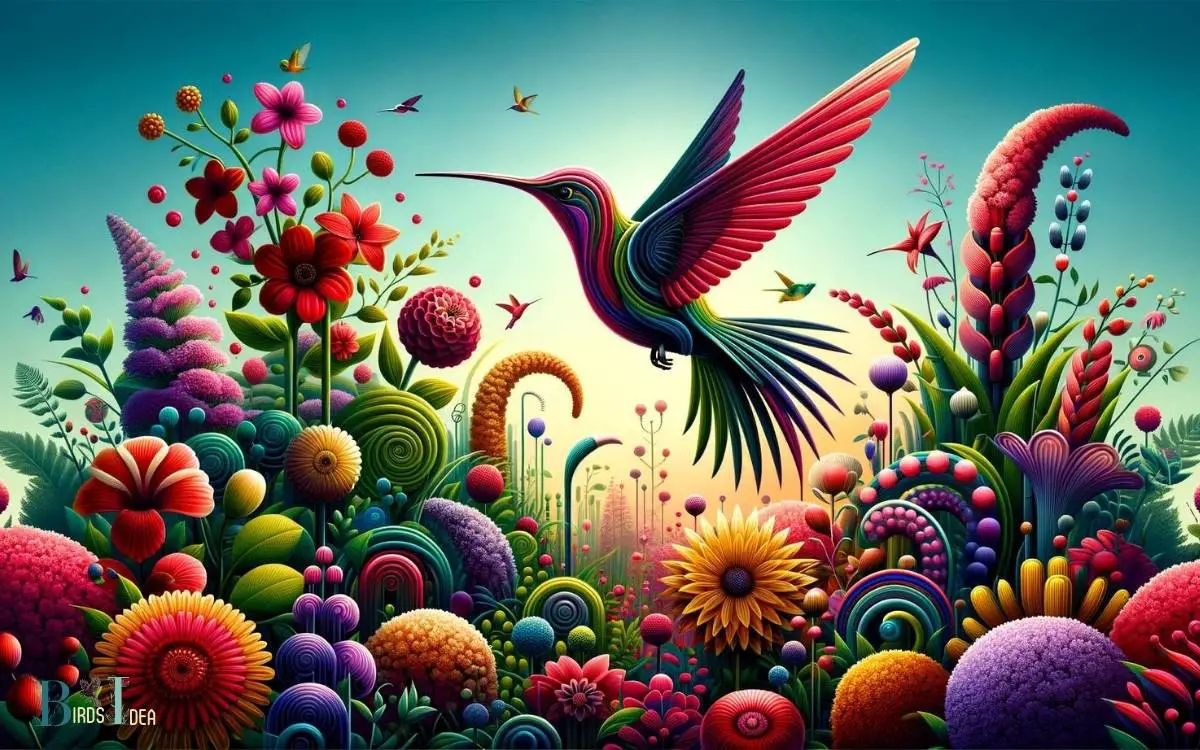
Key Takeaway
Importance of Hummingbird-Friendly Flowers
Hummingbird-friendly flowers are essential for attracting and supporting these delicate yet vital pollinators in garden environments.
These flowers provide a crucial food source for hummingbirds, offering the nectar that fuels their high-energy lifestyles.
By planting a variety of flowers that bloom at different times, gardeners can ensure a continuous nectar supply, supporting hummingbirds throughout the seasons.
Additionally, the presence of hummingbirds in the garden can help with natural pest control, as they consume insects and spiders in addition to nectar.
Choosing native, tubular-shaped flowers in vibrant shades of red, orange, and pink, such as trumpet vine, bee balm, and salvia, can be particularly effective in attracting hummingbirds due to their visual appeal and high nectar content.
In this way, planting hummingbird-friendly flowers not only beautifies the garden but also plays a crucial role in supporting these important pollinators.
Characteristics of Flowers Attractive to Hummingbirds
Attracting hummingbirds to your garden hinges on selecting flowers with characteristics that appeal to these avian pollinators.
Hummingbirds are attracted to brightly colored flowers, particularly red, orange, and pink hues.
These vibrant colors signal a high energy reward for the birds. Additionally, tubular-shaped flowers are well-suited for hummingbirds’ long, slender bills, allowing them to access the nectar inside.
Flowers with a high nectar volume and high sugar content are particularly attractive to hummingbirds as they provide the energy these birds need for their high metabolism.
Furthermore, selecting flowers that bloom at different times throughout the year ensures a consistent nectar source, encouraging hummingbirds to frequent your garden.
By incorporating these characteristics into your garden, you can create an inviting environment for these delightful avian visitors.
Best Flowering Plants for Hummingbirds
When selecting flowering plants for hummingbirds, it’s essential to consider the characteristics that attract them the most.
Colorful nectar-producing blooms and tubular-shaped flowers are particularly appealing to hummingbirds due to their high nectar content and easy access for the birds’ beaks.
By focusing on these specific plant features, you can create a welcoming environment that encourages hummingbirds to visit and frequent your garden.
Colorful Nectar-Producing Blooms
The presence of abundant nectar in vibrant, nectar-producing blooms is essential for attracting hummingbirds to your garden.
When selecting flowering plants to attract hummingbirds, consider the following options that are known for their colorful blooms and high nectar production:
- Salvia: With its tubular flowers in shades of red, pink, and purple, salvia is a favorite among hummingbirds.
- Bee Balm (Monarda): This plant produces vibrant, spiky flowers in shades of red, pink, and purple, which hummingbirds find irresistible.
- Trumpet Vine (Campsis radicans): Known for its trumpet-shaped, orange or red flowers, this vine provides abundant nectar for hummingbirds.
Tubular-Shaped Flowers for Beak
Abundant nectar in tubular-shaped flowers is especially beneficial for hummingbirds, as the shape of the blooms accommodates their unique beak structure and allows them to easily access the nectar.
Tubular-shaped flowers, such as trumpet vine, columbine, and bee balm, are perfectly suited to the long, slender beaks of hummingbirds.
Trumpet vine, for example, produces vibrant red, trumpet-shaped flowers that provide a generous amount of nectar, making it an irresistible choice for hummingbirds.
Columbine’s delicate, tubular blooms in shades of red, yellow, and orange are also well-loved by these birds.
Furthermore, bee balm, with its tubular, nectar-filled blossoms, is a favorite among hummingbirds.
These tubular-shaped flowers not only offer ample nectar but also provide a convenient and accessible food source for these delightful avian visitors.
Native Flowers and Their Appeal to Hummingbirds
Native flowers often attract hummingbirds due to their bright colors and high nectar content. Hummingbirds co-evolved with native flowers, making them particularly drawn to these plants.
Some native flowers that appeal to hummingbirds include:
- Cardinal Flower (Lobelia cardinalis): With its vibrant red tubular flowers, this native plant is a favorite among hummingbirds.
- Scarlet Beebalm (Monarda didyma): This native perennial produces bright red, tubular flowers that hummingbirds find irresistible.
- Coral Honeysuckle (Lonicera sempervirens): The tubular, coral-colored flowers of this native vine are a magnet for hummingbirds.
These native flowers not only provide sustenance for hummingbirds but also contribute to the ecological balance of their natural habitats.
By incorporating these plants into your garden, you can create a welcoming environment for these delightful creatures.
Color Preferences of Hummingbird-Friendly Flowers
Hummingbirds are known to be attracted to certain colors, and understanding their color preferences can help in creating a hummingbird-friendly garden.
The color of flowers can have a significant impact on their appeal to these tiny birds, with certain hues being more alluring than others.
By considering the influence of color on hummingbirds, gardeners can strategically select flowers that are more likely to attract and nourish these beautiful creatures.
Attracting Hummingbirds With Color
Hummingbirds are most attracted to flowers that are brightly colored, such as red, orange, and pink. These colors stand out to the birds and signal that the flowers are a good source of nectar.
When trying to attract hummingbirds to your garden, consider planting flowers in the following colors:
- Red: This vibrant color is highly attractive to hummingbirds and is often associated with tubular flowers that contain high amounts of nectar.
- Orange: Similar to red, orange flowers also catch the attention of hummingbirds and are a popular choice for attracting these birds to your garden.
- Pink: Soft pink flowers, especially those with tubular shapes, are also favored by hummingbirds and can help draw them to your garden.
Impact of Flower Color
Many hummingbird-friendly flowers exhibit a preference for vibrant hues such as red, orange, and pink, which are highly attractive to the avian species due to their association with high-nectar content.
These colors are easily visible to hummingbirds, who have excellent color vision, and are often associated with a high concentration of sucrose, a primary component of nectar.
While red is a particularly strong attractant for hummingbirds, they also show a preference for other bright colors, including orange and pink.
These hues are often found in tubular flowers, which are well-suited for the long, specialized bills of hummingbirds.
Additionally, some flowers may appear to change color as they are viewed from different angles, which may further enhance their appeal to hummingbirds.
Understanding these color preferences can help gardeners and wildlife enthusiasts choose the most attractive flowers for hummingbirds.
Seasonal Blooms and Hummingbird Visits
During the spring and summer months, certain flowers bloom to attract hummingbirds to their nectar-filled blossoms.
These seasonal blooms are essential for providing a nectar source for the hummingbirds, ensuring their sustenance during these active months.
The following are some examples of flowers that bloom during spring and summer, attracting hummingbirds to their vibrant blossoms:
- Trumpet Vine (Campsis radicans): This vigorous vine produces bright orange or red trumpet-shaped flowers that are particularly attractive to hummingbirds.
- Bee Balm (Monarda): Known for its unique, spiky flowers in shades of red, pink, and purple, bee balm is a favorite of hummingbirds.
- Cardinal Flower (Lobelia cardinalis): This striking perennial produces tall spikes of vibrant red flowers, making it a magnet for hummingbirds seeking nectar.
These seasonal blooms play a crucial role in supporting the hummingbird population during their active breeding and foraging period.
Perennial Vs. Annual Flowers for Hummingbirds
When selecting flowers to attract hummingbirds, it is important to consider the differences between perennial and annual blooms.
Perennial flowers, which bloom year after year, provide a consistent food source for hummingbirds and require less effort once established.
On the other hand, annual flowers bloom for just one season but often produce more nectar, attracting hummingbirds with abundant food sources.
Here’s a comparison of perennial and annual flowers for hummingbirds:
| Perennial Flowers | Annual Flowers |
|---|---|
| Bee Balm | Salvia |
| Columbine | Fuchsia |
| Trumpet Vine | Petunia |
| Bleeding Heart | Cardinal Flower |
Both types of flowers offer unique benefits for attracting and sustaining hummingbirds in your garden.
Consider incorporating a mix of perennial and annual blooms to provide a continuous and varied food source for these delightful birds.
Creating a Balanced Hummingbird Garden
To create a balanced hummingbird garden, it is essential to carefully select a diverse range of flowers that provide a continuous and varied food source throughout the year.
This can be achieved by incorporating a mix of perennial and annual flowers that bloom at different times, ensuring a consistent nectar supply for hummingbirds.
Additionally, choosing flowers of varying shapes and sizes will cater to the specific feeding preferences of different hummingbird species.
It’s also important to include native flowers, as they are adapted to the local climate and will thrive, providing a reliable food source for hummingbirds.
Lastly, integrating tubular flowers, such as salvia, penstemon, and columbine, will attract hummingbirds with their nectar-rich blooms.
- Incorporate a mix of perennial and annual flowers
- Choose flowers of varying shapes and sizes
- Include native flowers adapted to the local climate
Conclusion
It is absolutely crucial to select the right type of flowers in order to attract hummingbirds to your garden.
The characteristics, colors, and seasonal blooms of the flowers play a vital role in appealing to these magnificent creatures.
By carefully choosing native, perennial flowering plants, you can create a harmonious and balanced hummingbird garden that will not only attract these beautiful birds, but also contribute to the ecosystem in a significant way.

